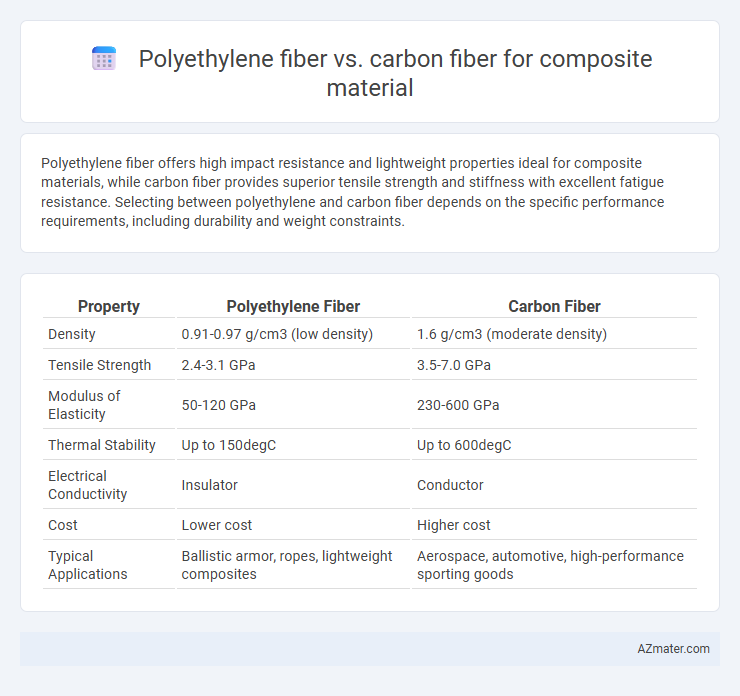Polyethylene fiber offers high impact resistance and lightweight properties ideal for composite materials, while carbon fiber provides superior tensile strength and stiffness with excellent fatigue resistance. Selecting between polyethylene and carbon fiber depends on the specific performance requirements, including durability and weight constraints.
Table of Comparison
| Property | Polyethylene Fiber | Carbon Fiber |
|---|---|---|
| Density | 0.91-0.97 g/cm3 (low density) | 1.6 g/cm3 (moderate density) |
| Tensile Strength | 2.4-3.1 GPa | 3.5-7.0 GPa |
| Modulus of Elasticity | 50-120 GPa | 230-600 GPa |
| Thermal Stability | Up to 150degC | Up to 600degC |
| Electrical Conductivity | Insulator | Conductor |
| Cost | Lower cost | Higher cost |
| Typical Applications | Ballistic armor, ropes, lightweight composites | Aerospace, automotive, high-performance sporting goods |
Introduction to Polyethylene and Carbon Fiber Composites
Polyethylene fiber composites exhibit exceptional toughness and impact resistance due to their high molecular weight and crystallinity, making them ideal for applications requiring lightweight and flexible materials. Carbon fiber composites offer superior stiffness, high tensile strength, and excellent fatigue resistance, attributed to tightly bonded carbon atoms arranged in a crystalline structure, suitable for aerospace and automotive industries. Both materials provide unique mechanical properties and chemical resistance, with polyethylene excelling in energy absorption and carbon fiber dominating in structural rigidity and thermal stability.
Material Composition and Structure
Polyethylene fiber is composed of ultra-high-molecular-weight polyethylene (UHMWPE) chains arranged in a highly crystalline, linear structure, resulting in strong intermolecular bonding and excellent toughness. Carbon fiber consists of thin strands of carbon atoms bonded in a hexagonal lattice, forming a rigid, lightweight material with high tensile strength and stiffness due to its graphitic crystalline structure. The molecular arrangement in polyethylene fiber emphasizes flexibility and impact resistance, whereas carbon fiber's layered atomic structure provides superior rigidity and thermal conductivity in composite materials.
Mechanical Strength Comparison
Carbon fiber exhibits superior mechanical strength with a tensile strength typically exceeding 3,500 MPa, making it ideal for high-stress applications in aerospace and automotive industries. Polyethylene fiber, such as Ultra-High-Molecular-Weight Polyethylene (UHMWPE), offers impressive tensile strength around 2,500 MPa but excels in impact resistance and lightweight properties. The stiffness of carbon fiber, with a modulus of approximately 230 GPa, significantly outperforms polyethylene fiber's modulus near 115 GPa, influencing load-bearing capacity and structural rigidity in composite materials.
Weight and Density Differences
Polyethylene fiber exhibits a density of approximately 0.97 g/cm3, making it significantly lighter than carbon fiber, which typically has a density around 1.6 g/cm3. This lower density contributes to polyethylene's advantage in applications requiring ultra-lightweight composites, whereas carbon fiber's higher density corresponds with superior stiffness and strength. Weight differences crucially impact composite design choices, with polyethylene fibers favoring weight reduction and carbon fibers offering enhanced structural performance.
Flexibility and Toughness
Polyethylene fiber exhibits superior flexibility and impact toughness, making it ideal for applications requiring high energy absorption and deformation without failure. Carbon fiber offers exceptional stiffness and tensile strength but tends to be more brittle, limiting its ability to flex under stress. In composite materials, polyethylene fibers enhance durability and resistance to crack propagation, while carbon fibers provide structural rigidity and high load-bearing capacity.
Chemical and Environmental Resistance
Polyethylene fiber exhibits exceptional chemical resistance, resisting most acids, bases, and solvents, making it ideal for harsh chemical environments, while carbon fiber offers superior environmental resistance, including excellent UV and corrosion resistance. Polyethylene's low moisture absorption enhances durability in wet or marine conditions, whereas carbon fiber's rigid structure provides better resistance to temperature fluctuations and oxidative degradation. Choosing between them depends on specific chemical exposure and environmental conditions of the composite application.
Cost and Availability
Polyethylene fiber is significantly more affordable than carbon fiber, making it a cost-effective choice for large-scale composite applications. Carbon fiber offers superior strength-to-weight ratio but commands higher prices due to complex manufacturing processes and limited raw material availability. Polyethylene fibers are widely accessible and produced in bulk, while carbon fiber supply can be constrained by specialized production facilities and higher demand in aerospace and automotive industries.
Manufacturing Processes
Polyethylene fiber composites typically involve melt spinning and gel spinning processes that produce ultra-high-molecular-weight polyethylene (UHMWPE) fibers, offering excellent tensile strength and chemical resistance. Carbon fiber composites are manufactured through precursor stabilization, carbonization, and surface treatment, resulting in fibers with superior stiffness and strength suitable for aerospace and automotive applications. The choice between polyethylene and carbon fiber in composite manufacturing depends on processing temperatures, mechanical performance requirements, and cost considerations.
Typical Applications in Industry
Polyethylene fiber is commonly used in ballistic protection, sports equipment, and ropes due to its high impact resistance and lightweight properties. Carbon fiber dominates aerospace, automotive, and wind energy industries for its exceptional strength-to-weight ratio and stiffness. Both materials offer unique advantages tailored to specific industrial composite applications based on performance requirements.
Future Trends and Innovations
Polyethylene fiber and carbon fiber both play critical roles in advancing composite material technology, with polyethylene offering exceptional impact resistance and carbon fiber providing superior strength-to-weight ratios. Future trends indicate growing innovation in hybrid composites that combine polyethylene's durability with carbon fiber's stiffness for enhanced performance in aerospace and automotive industries. Research also focuses on improving recyclability and reducing environmental impact through bio-based fibers and advanced matrix materials, driving more sustainable composite solutions.

Infographic: Polyethylene fiber vs Carbon fiber for Composite material
 azmater.com
azmater.com